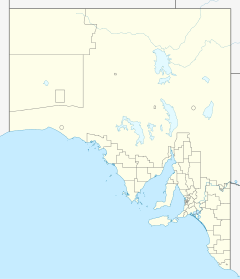Ngarutjaranya: Difference between revisions
Rescuing 2 sources and tagging 0 as dead. #IABot (v1.6.2) |
|||
| Line 30: | Line 30: | ||
== History == |
== History == |
||
William Ernest Giles was the first white man to pass through the area and camped to the south Woodroffe on September 7, 1873. [[William Gosse (explorer)|William Christie Gosse]] named Mt Woodroffe |
William Ernest Giles was the first white man to pass through the area and camped to the south of Woodroffe on September 7, 1873. [[William Gosse (explorer)|William Christie Gosse]] named Mt Woodroffe on July 20, 1873 and passed to the north of the mountain on October 27, 1873.<ref>{{cite web | url=https://plus.google.com/photos/114227224291694092298/albums/6047791436243456097/6047792317544658626?banner=pwa&authkey=CLL7s7fnpe75bQ&pid=6047792317544658626&oid=114227224291694092298 | title = Plaque on the summit of Woodroffe. | publisher = state8.net/sa.htm}}</ref> Woodroffe was named after [[George Woodroffe Goyder]], Surveyor-General of South Australia and an early Australian explorer.<ref>{{cite web |url=http://adb.anu.edu.au/biography/goyder-george-woodroffe-3647 |title = Goyder, George Woodroffe (1826-1898) | work = Australian Dictionary of Biography.|publisher = Melbourne University Press. | year = 1972 | accessdate = 2 September 2014}}</ref> |
||
In the 1960s Mount Woodroffe was considered as a potential site for the proposed [[Anglo-Australian Telescope|Anglo-Australian Telescope (AAT)]]. It lost out due to its remoteness compared to [[Siding Spring Observatory|Siding Spring]] in [[New South Wales]], where the AAT sits today amongst other astronomical observatories.<ref>Biographical Memoir of Arthur Robert Hogg, 1903-1966, Australian Academy of Science {{cite web |url=http://www.science.org.au/academy/memoirs/hogg.htm |title=Archived copy |accessdate=2007-07-16 |deadurl=yes |archiveurl=https://web.archive.org/web/20070810222243/http://www.science.org.au/academy/memoirs/hogg.htm |archivedate=2007-08-10 |df= }}</ref> |
In the 1960s Mount Woodroffe was considered as a potential site for the proposed [[Anglo-Australian Telescope|Anglo-Australian Telescope (AAT)]]. It lost out due to its remoteness compared to [[Siding Spring Observatory|Siding Spring]] in [[New South Wales]], where the AAT sits today amongst other astronomical observatories.<ref>Biographical Memoir of Arthur Robert Hogg, 1903-1966, Australian Academy of Science {{cite web |url=http://www.science.org.au/academy/memoirs/hogg.htm |title=Archived copy |accessdate=2007-07-16 |deadurl=yes |archiveurl=https://web.archive.org/web/20070810222243/http://www.science.org.au/academy/memoirs/hogg.htm |archivedate=2007-08-10 |df= }}</ref> |
||
Revision as of 02:51, 10 October 2018
| Mount Woodroffe (Ngarutjaranya) | |
|---|---|
| Highest point | |
| Elevation | 1,435 m (4,708 ft)AHD |
| Prominence | South Australia's highest mountain |
| Coordinates | 26°19′S 131°44′E / 26.317°S 131.733°E |
| Geography | |
| Location | South Australia, Australia |
| Parent range | Musgrave Ranges |
| Climbing | |
| Easiest route | Hike |
Mount Woodroffe is South Australia's highest peak, at 1,435 metres.
Cultural significance
The mountain is known to the Pitjantjatjara Indigenous Australians as Ngarutjaranya.[1] In Indigenous Australian mythology, the mountain embodies the mythological creature Ngintaka.
Geography
Mount Woodroffe is located in the far northwest of South Australia, in the Musgrave Ranges. The mountain range rises some 700–800 metres from the surrounding plains and comprises massifs of granite and gneiss.
History
William Ernest Giles was the first white man to pass through the area and camped to the south of Woodroffe on September 7, 1873. William Christie Gosse named Mt Woodroffe on July 20, 1873 and passed to the north of the mountain on October 27, 1873.[2] Woodroffe was named after George Woodroffe Goyder, Surveyor-General of South Australia and an early Australian explorer.[3]
In the 1960s Mount Woodroffe was considered as a potential site for the proposed Anglo-Australian Telescope (AAT). It lost out due to its remoteness compared to Siding Spring in New South Wales, where the AAT sits today amongst other astronomical observatories.[4]
Access
Access is limited as a permit is required to enter the Anangu Pitjantjatjara lands.[5]
See also
References
- ^ "Mount Woodroffe". Gazetteer of Australia online. Geoscience Australia, Australian Government.
- ^ "Plaque on the summit of Woodroffe". state8.net/sa.htm.
- ^ "Goyder, George Woodroffe (1826-1898)". Australian Dictionary of Biography. Melbourne University Press. 1972. Retrieved 2 September 2014.
- ^ Biographical Memoir of Arthur Robert Hogg, 1903-1966, Australian Academy of Science "Archived copy". Archived from the original on 2007-08-10. Retrieved 2007-07-16.
{{cite web}}: Unknown parameter|deadurl=ignored (|url-status=suggested) (help)CS1 maint: archived copy as title (link) - ^ "Permits". PYMedia. Archived from the original on 2004-07-25. Retrieved 2006-07-30.
{{cite web}}: Unknown parameter|deadurl=ignored (|url-status=suggested) (help)


